A folding saw is one of the most practical multipurpose tools you can bring into the bush.
It can be used to clear brush, build a shelter, saw through bone, or cut wood to size for a stove (to name just a few uses).
Because of a folding saw’s many uses, I recommend it over other tools like a survival axe. Since folding saws are lightweight but do a better job than hand saws or knives, they are worth carrying in your pack.
Every survivalist has their favorite folding saw.
Here’s a review of my top picks for the best folding saws for ultralight, heavy-duty, bushcraft, low budget, and all-around use.
Best Folding Hand Saw Reviews
 Bahco Laplander
Bahco Laplander
When it comes to the top performers, the Bahco Laplander is always mentioned.
There is a good reason for this. It is designed to serve almost any function you could think of. Unlike other “general purpose” saws, the Laplander is up to the tasks.
The Laplander’s main features are XT toothing that will cut on the push and pull. This makes it great for beginners who might mistakenly apply pressure on the push.
Note that the blade is thin and flexible. It will bend! However, it is easy to bend the blade back into shape.
You can buy replacement blades for the Laplander (which you can get here) for a reasonable cost. This is important since some replacement blades cost as much as the saw.
- Locks in open and closed position
- Cuts on push and pull
- Replacement blades are reasonably priced
- Good for beginners
- The blade is flexible and will bend
- Dark color makes it easy to lose in the bush
 Silky PocketBoy 5"
Silky PocketBoy 5"
There used to be a few brands that made ultralight folding saws under 4oz. These folding saws were pretty useless, though, and got discontinued.
If you need a folding saw that light, you are probably limited to the saw on your multi-tool or a knife with serration.
However, you can find a good folding saw under 6oz. Case point? The PocketBoy by Silky is a popular saw that weighs only 5.6oz.
It performs very well, considering its size. It has a very pronounced pull stroke that makes cutting a breeze.
The blade also holds its edge very well. You’ll still need to sharpen, or you can replace the blade.
There are medium, large, and fine-toothed blades available for the PocketBoy and different blade lengths. All blades are interchangeable within their length.
The PocketBoy blade cuts on the pull stroke, which is easier to control and requires less energy. However, it won’t be as efficient as a blade that cuts on both the push and pull.
- Very small and lightweight
- Fits on your belt
- Slip-resistant handle
- Two cutting positions
- Interchangeable blades
- Cuts on pull stroke
- Carrying case is plastic
- Blade doesn’t lock in closed position
 Silky Professional BIGBOY
Silky Professional BIGBOY
Here’s another folding saw by Silky. This time, it is a beast of a saw meant to cut through large branches.
It is even suitable for some construction projects. Yes, it will cut through green wood and logs!
Because it is so large and heavy, this isn’t a folding saw you’ll want to put in your survival pack. It’s better for camping from your vehicle.
For bushcraft, I’d only take it if I knew I would be in the field at one location for a longer time.
For a sizeable folding saw, the BigBoy has a very thin blade. This helps reduce weight but can also cause issues like bending.
To prevent bending, you must be careful with how you apply pressure. The blade only cuts on the pull stroke. During the pull, you cannot apply any pressure at all.
You’ll also want to make an undercut through larger tree limbs, or you’ll end up with blade binding issues.
- Extremely sharp
- Cuts through large limbs with ease
- Maintains sharpness well
- Thin blade
- Replacement blades are pricey
- Doesn’t come with a sheath
- Not good choice for beginners
- No lock in closed position
 Opinel Folding Saw
Opinel Folding Saw
As far as beautiful folding saws go, it’s hard to beat the Opinel. It is made in France from beech wood.
This adds to the saw’s cost but feels much better in your hand than plastic.
Do note that the handle is wide at the end. The extra width is great for large hands but not for smaller ones.
Compared to the Laplander, the Opinel cuts more cleanly and even faster. This has to do with the narrow blade with large offset teeth.
As with many folding saws, the Opinel doesn’t lock in the closed position. The lock is also a bit flimsy. It is easy to fix if it malfunctions, though.
Because of its adequate size, ability to cut through large branches, and lightweight, this is a great folding saw for camping or bushcraft.
- Made from wood
- Cuts very cleanly and quickly
- Lightweight
- Good for large hands
- Replacement blades are reasonably priced
- Doesn’t lock in closed position
- Lock is flimsy
- Sheath not included
 Corona RazorTooth
Corona RazorTooth
The Corona RazorTooth is another product that always gets mentioned. Part of the reason people love it so much is because it is cheap. Considering the low price, it holds up very well.
I love that there is a very aggressive blade pattern on the RazorTooth saw. It makes cutting through logs easy.
The blade handle is also comfortable enough to use for extended periods. Like most folding saws, it only cuts on the pull.
As you’d expect with a cheap folding saw, some flaws exist. The curved saw has some teeth exposed when in the closed position.
The lanyard hole is virtually useless since the blade goes to the hole – potentially cutting your cord.
You will also pay nearly as much as the saw itself for replacement blades.
The saw comes in sizes 7″, 8″, and 10″. The smaller sizes perform just as well.
But if you need a smaller folding saw, I would opt for the Bahco Laplander instead. The Bahco only costs a few dollars more and is better for field tasks.
- Available in multiple sizes
- Aggressive tooth pattern
- Locks in an open and closed position
- Comfortable handle
- Low price
- Replacement blades cost nearly as much as the entire saw
- Some teeth exposed in closed position
- No sheath
Choosing a Folding Hand Saw
How Will You Use It?
The most important thing to consider when choosing a folding saw is how you will use it.
Getting a 10″ folding saw (no matter how good of quality) is pointless if you need something to carry while hiking.
Likewise, you won’t want a small, lightweight folding saw if you need to cut large branches, such as when building a bushcraft cabin!
Size and Weight
If you are car camping, these issues shouldn’t matter too much. But if you want to carry the folding saw into the bush, you’ll need something more portable.
It used to be that only big, heavy saws could cut through large branches. However, there are now quality compact saws that can cut through large branches, too.
Expect to pay more for blades that can offer cutting power without adding much weight.
Blade Material
Most of the best folding saws are made from high carbon steel. This allows them to remain lightweight while still cutting well.
Carbon steel requires special maintenance. Make sure that it is always clean and dry before putting it away.
If you plan on using the folding saw in a humid environment, you will probably want to look for a stainless, rust-proof blade material.
Teeth Per Inch
Again, consider how you plan on using the folding saw. Teeth per inch (TPI) is the number you need to look at.
One with lots of TPI will make smoother cuts, but it will take much longer to cut through wood.
Saws with fewer teeth per inch will cut faster but make very coarse cuts.
Cuts On the Push or Pull?
Saws can be push or pull stroke. Most folding saws only cut on the pull. This allows the blade to be thinner. It also gives more control over the cut and produces more precise cuts. A pull-only saw is better if you need to cut precise straight lines.
Saws that cut on both the push and pull are much more efficient. However, they are very aggressive and harder to control the cut. You won’t get a clean finish with these saws.
Note that beginners generally prefer saws that cut on both the push and pull. It is easy to forget not to apply pressure on pull-only saws. This can cause the saw to jam in the wood.
Handle Material, Grip and Feel
One major drawback of these short-bladed saws is hand fatigue; a couple of hours using one of these things will undoubtedly give your arms a workout.
This fatigue can be best managed by choosing a saw with a suitable handle. All of our selected products have quality handles, but some are better suited to specific jobs than others.
Look for the following qualities in a handle when making your decision;
- Shape: An ergonomic shape and finger indentations will allow for a more comfortable grip
- Size: Your hand size is essential, and some blades will suit larger hands; this is mentioned in the individual reviews where appropriate
- Material: It comes down to preference; some will prefer the traditional feel of a wooden handle, but a rubber-like handle will offer some padding and will be easier to grip in wet conditions
- Protection: Does the handle cover the whole of the blade when folded up? Some cheaper options leave teeth exposed, which is not ideal if you want to keep the saw in your pocket.
Locking Mechanism
It might seem trivial, but pay attention to the locking mechanism of the folding saw.
It is much safer to get a saw with a lock in the closed position.
However, some people hate pushing the unlock button each time they grab the saw.
I prefer this annoyance over the risk of cutting my hand while reaching for the saw!
Replacement Blades
Before buying any folding saw, look at the cost of replacement blades. A saw might seem like a good deal until you factor in the price of a new blade.
Of course, you could always learn to sharpen your saw blade – but this can be a somewhat complicated task. The same goes for reshaping a bent saw blade.
So, if you aren’t a sharpening expert, expect to buy replacement blades reasonably often.
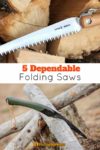

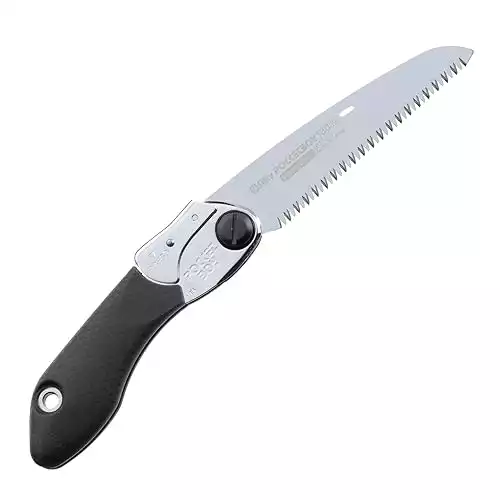
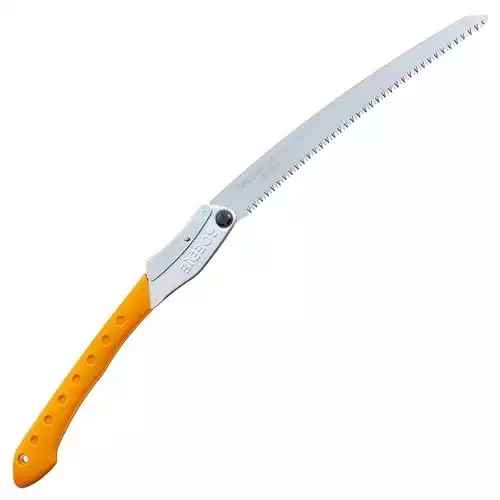
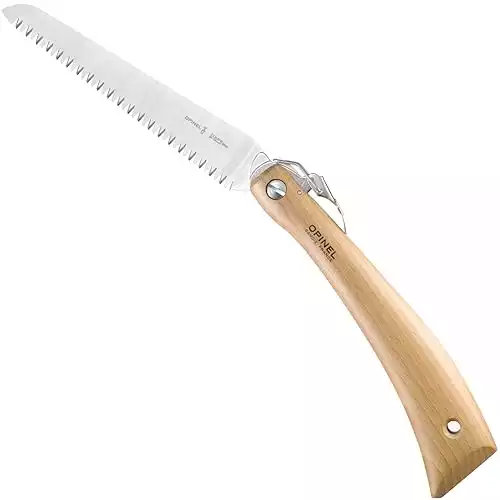
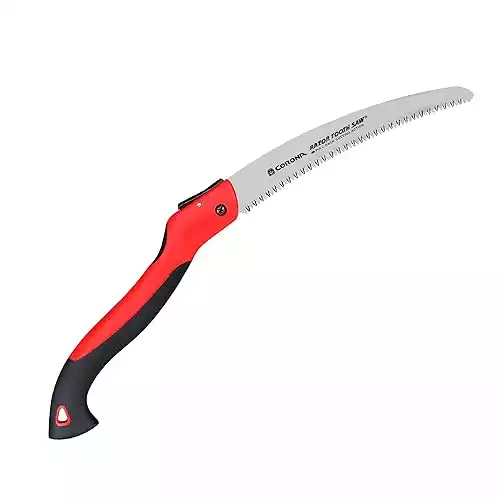


Silky.
If yous ascribe to the concept that we survive out of our pockets, I bought the 130 Pocketboy by accident, I thought I was getting a bigger saw. A fortuitous mistake, this thing fits in my pocket, and out cuts my Leatherman or SAK saws. The other thing about saws is that when your dehydrated and calorie deficient, saws burn fewer calories in use.
Check out Japanese folding saws, they work like the Bigboy and ‘bite’ during the pull phase.
Using this type of saw is much more energy efficient than our Occidental pushing saws, and the pulling movement also makes for cleaner cuts, it is easier to control and it limits wear and folding of the blade.
Many of these saws also come with easily replaceable blades.
For quick-and-dirty bushcraft use, the number of teeth per inch (TPI) should be less than 13 TPI, which makes for an ‘aggressive’ bite. But if you want to do precise carpentry work, then go for a blade that has a higher TPI number: it will cut much slower but the cut is cleaner. I hope this helps!
Great info – thanks
In the review of the BigBoy it says that “the blade only cuts on the pull stroke. During the pull you cannot apply any pressure at all”. Is this right?
No – you apply the pressure on the pull and no pressure on the push.
Good study. However the Opinel is about double the price of the Laplander, making the choice easier. I use the Laplander for some 10 yrs now and to my full satisfaction.
Laplander is our top pick also, great tool which deserves all the praise it gets.